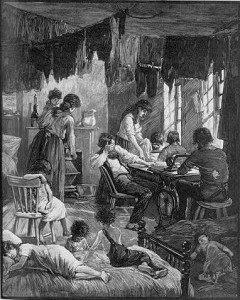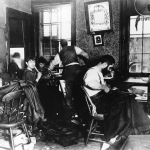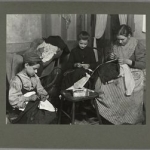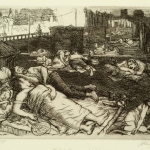
Bror Thure de Thulstrup (1848-1930)|Homes of the poor, 1883|Cover illustration for Harper's Weekly (July 28, 1883): 465 (title page)|wood engraving|Library of Congress, Prints and Photographs Collections
In the middle of the summer of 1883, Harper’s Weekly chose to describe and illustrate the deplorable living and working conditions found in immigrant homes in the tenements of New York City. The front page illustration Homes of the poor was created by Bror Thure de Thulstrup to illustrate the Harper’s Weekly article, “Tenement Houses in Summer” (no author indicated).
Bror Thure de Thulstrup was a Swedish-born American illustrator who immigrated to the United States after having served as an artillery officer in the Swedish military, in the French Foreign Legion, and worked in Canada as a civil engineer. After his 1873 move to the United States Thure de Thulstrup began his career as an illustration artist having studied at the Art Students League. By 1887 he was under contract to Harper’s Weekly to produce a full or double page image every week.*
Thure de Thulstrup’s illustration is of an interior view of New York City tenement lodging crowded with men, women, and children; some working, one even using a peddle operated sewing machine. The busy room seems to be the residence of two families since there appear to be two sets of adults working in the space and a troop of eight children of various ages. Within this illustration we can see two beds, a number of chairs and a stool, a cast iron stove located in front of the fireplace, and many raggedy articles of clothing hanging from lines strung across the ceiling. At night light for this living space appears to come solely from a half used candle stuck into the neck of a bottle waiting on the fireplace mantel.
The magazine’s article on one hand deplores the inadequate housing provided in New York’s tenements as “unfit for human habitation,” and on the other places some of the blame for these conditions on the heads of the tenement’s occupants by describing some of them as miserly. Another interesting and counter-intuitive revelation in this 1883 article is found in a sentence in the last half of the article, “The old saying that half of the world knows not how the other half lives is much less than the truth concerning New York.” ** The author goes on to say that the privileged of the city know not how the other three-quarters of the population live. The use of the phrase, how the other half lives took on greater meaning when in 1890 the New York Tribune reporter Jacob Riis turned his camera and pen to the issue of unsavory and unhealthy tenement life in Manhattan.
Thure de Thulstrup’s illustration for Harper’s Weekly and the accompanying article clearly indicate that the issue of crowding in New York City’s tenements as well as the deplorable living conditions for the immigrant poor was a topic for concern well before Riis took aim at the subject in his book-length plea for housing reform in, How the Other Half Lives.

Jacob A. Riis (1849-1914)|“Knee Pants” at forty-five cents a dozen—a Ludlow Street Sweater’s Shop, c. 1889|photograph|Published in Chapter XI “The Sweaters of Jewtown” of How the Other Half Lives by J. A. Riis (1890)
Reformers continued to write and promote better domestic conditions for all Americans. At the end of the 19th century, Dr. E. R. L. Gould wrote an article published in the Quarterly Review of Economics entitled “The Housing Problem in Great Cities.” *** The issue according to Gould was that “The home is the character unit of society; and, where there is little or no opportunity for the free play of influences which make for health, happiness, and virtue, we must expect social degeneration and decay.” In later articles Gould would advocate building tenement apartment buildings around air and light wells with four separate stairways for the block and locating each in its quadrant for safety sake and where each apartment was made of multiple rooms.
It was not until the first and second decades of the 20th century that American Realist artists (also known as the Ash Can School) such as John Sloan made images and illustrations reflecting New York’s tenement life. For Sloan, these scenes merely referenced his own experiences and what he could see from his West 23rd Street apartment windows in New York having moved there from Philadelphia in 1904.
A few years later continuing concern over living and working conditions in New York tenements prompted photographer Lewis W. Hine to revisit this and other related topics. His documentary photos include visual evidence of child labor and the poor working conditions for immigrants and the impoverished.

Lewis Wickes Hine (1874-1940)|Documentary Photograph|Mrs. Battaglia, Tessie, 12, and Tony, 7... finishing men's trousers, January 1908|New York Public Library
* This contract earned Thure de Thulstrup about $10,000 a year according to an article in Public Opinion.
** “Tenement-Houses in Summer” in Harper’s Weekly v. XXVII no. 1388 (July 28,1883): 475.
*** E. R. L. Gould, “The Housing Problem in Great Cities” in Quarterly Review of Economics 14 (1899-1900): 378-93. See also, “Model Tenements Not a Failure, says Dr. E.R.L. Gould” The New York Times (January 19, 1913) Magazine Section Part Five, Page SM13. Dr. Elgin Ralston Lovell Gould (1860-1915) of New York specialized in urban studies and the life in ‘modern’ cities.
July 15, 2010
By Joyce K. Schiller, Curator, Rockwell Center for American Visual Studies
Norman Rockwell Museum







